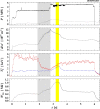Demonstration of reduced neoclassical energy transport in Wendelstein 7-X
- PMID: 34381232
- PMCID: PMC8357633
- DOI: 10.1038/s41586-021-03687-w
Demonstration of reduced neoclassical energy transport in Wendelstein 7-X
Erratum in
-
Publisher Correction: Demonstration of reduced neoclassical energy transport in Wendelstein 7-X.Nature. 2021 Oct;598(7882):E5. doi: 10.1038/s41586-021-04023-y. Nature. 2021. PMID: 34642470 Free PMC article. No abstract available.
Abstract
Research on magnetic confinement of high-temperature plasmas has the ultimate goal of harnessing nuclear fusion for the production of electricity. Although the tokamak1 is the leading toroidal magnetic-confinement concept, it is not without shortcomings and the fusion community has therefore also pursued alternative concepts such as the stellarator. Unlike axisymmetric tokamaks, stellarators possess a three-dimensional (3D) magnetic field geometry. The availability of this additional dimension opens up an extensive configuration space for computational optimization of both the field geometry itself and the current-carrying coils that produce it. Such an optimization was undertaken in designing Wendelstein 7-X (W7-X)2, a large helical-axis advanced stellarator (HELIAS), which began operation in 2015 at Greifswald, Germany. A major drawback of 3D magnetic field geometry, however, is that it introduces a strong temperature dependence into the stellarator's non-turbulent 'neoclassical' energy transport. Indeed, such energy losses will become prohibitive in high-temperature reactor plasmas unless a strong reduction of the geometrical factor associated with this transport can be achieved; such a reduction was therefore a principal goal of the design of W7-X. In spite of the modest heating power currently available, W7-X has already been able to achieve high-temperature plasma conditions during its 2017 and 2018 experimental campaigns, producing record values of the fusion triple product for such stellarator plasmas3,4. The triple product of plasma density, ion temperature and energy confinement time is used in fusion research as a figure of merit, as it must attain a certain threshold value before net-energy-producing operation of a reactor becomes possible1,5. Here we demonstrate that such record values provide evidence for reduced neoclassical energy transport in W7-X, as the plasma profiles that produced these results could not have been obtained in stellarators lacking a comparably high level of neoclassical optimization.
© 2021. The Author(s).
Conflict of interest statement
The authors declare no competing interests.
Figures






References
-
- Wesson, J. Tokamaks 2nd edn (Oxford Univ. Press, 1997).
-
- Grieger G, et al. Modular stellarator reactors and plans for Wendelstein 7-X. Fusion Technol. 1992;21:1767–1778.
-
- Pedersen TS, et al. First results from divertor operation in Wendelstein 7-X. Plasma Phys. Contr. Fusion. 2019;61:014035.
-
- Lawson JD. Some criteria for a power producing thermonuclear reactor. Proc. Phys. Soc. B. 1957;70:6–10.

